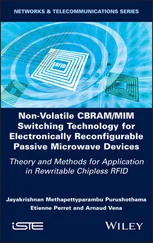Joel P. Dunsmore - Handbook of Microwave Component Measurements
Здесь есть возможность читать онлайн «Joel P. Dunsmore - Handbook of Microwave Component Measurements» — ознакомительный отрывок электронной книги совершенно бесплатно, а после прочтения отрывка купить полную версию. В некоторых случаях можно слушать аудио, скачать через торрент в формате fb2 и присутствует краткое содержание. Жанр: unrecognised, на английском языке. Описание произведения, (предисловие) а так же отзывы посетителей доступны на портале библиотеки ЛибКат.
- Название:Handbook of Microwave Component Measurements
- Автор:
- Жанр:
- Год:неизвестен
- ISBN:нет данных
- Рейтинг книги:5 / 5. Голосов: 1
-
Избранное:Добавить в избранное
- Отзывы:
-
Ваша оценка:
- 100
- 1
- 2
- 3
- 4
- 5
Handbook of Microwave Component Measurements: краткое содержание, описание и аннотация
Предлагаем к чтению аннотацию, описание, краткое содержание или предисловие (зависит от того, что написал сам автор книги «Handbook of Microwave Component Measurements»). Если вы не нашли необходимую информацию о книге — напишите в комментариях, мы постараемся отыскать её.
Handbook of Microwave Component Measurements — читать онлайн ознакомительный отрывок
Ниже представлен текст книги, разбитый по страницам. Система сохранения места последней прочитанной страницы, позволяет с удобством читать онлайн бесплатно книгу «Handbook of Microwave Component Measurements», без необходимости каждый раз заново искать на чём Вы остановились. Поставьте закладку, и сможете в любой момент перейти на страницу, на которой закончили чтение.
Интервал:
Закладка:
MATLAB ®is a trademark of The MathWorks, Inc. and is used with permission. The MathWorks does not warrant the accuracy of the text or exercises in this book. This work's use or discussion of MATLAB ®software or related products does not constitute endorsement or sponsorship by The MathWorks of a particular pedagogical approach or particular use of the MATLAB ®software.
While the publisher and authors have used their best efforts in preparing this work, they make no representations or warranties with respect to the accuracy or completeness of the contents of this work and specifically disclaim all warranties, including without limitation any implied warranties of merchantability or fitness for a particular purpose. No warranty may be created or extended by sales representatives, written sales materials or promotional statements for this work. The fact that an organization, website, or product is referred to in this work as a citation and/or potential source of further information does not mean that the publisher and authors endorse the information or services the organization, website, or product may provide or recommendations it may make. This work is sold with the understanding that the publisher is not engaged in rendering professional services. The advice and strategies contained herein may not be suitable for your situation. You should consult with a specialist where appropriate. Further, readers should be aware that websites listed in this work may have changed or disappeared between when this work was written and when it is read. Neither the publisher nor authors shall be liable for any loss of profit or any other commercial damages, including but not limited to special, incidental, consequential, or other damages.
Library of Congress Cataloging‐in‐Publication Data
Names: Dunsmore, Joel P., author.
Title: Handbook of microwave component measurements : with advanced VNA techniques / Joel P. Dunsmore.
Description: Second edition. | Hoboken, NJ : John Wiley & Sons, Inc.,
[2020] | Includes bibliographical references and index.
Identifiers: LCCN 2020003649 (print) | LCCN 2020003650 (ebook) | ISBN
9781119477136 (hardback) | ISBN 9781119477112 (adobe pdf) | ISBN 9781119477129 (epub)
Subjects: LCSH: Microwave devices–Testing.
Classification: LCC TK7876 .D84 2020 (print) | LCC TK7876 (ebook) | DDC 621.381/330287–dc23
LC record available at https://lccn.loc.gov/2020003649
LC ebook record available at https://lccn.loc.gov/2020003650
Cover design: Wiley
Cover image: Created by Joel Dunsmore, © Tuomas Lehtinen/Getty Images
To my dear wife Dana
Foreword to the Second Edition
Our world today is perpetually changing due to advancements in technology. As we begin the new decade, we are on the verge of large‐scale 5G deployments that will enable richer services across more devices while driving higher performance across the entire network, from the device to the edge to the core. Automotive capabilities are continuing the march toward progressively higher levels of autonomy. The number of connected devices being deployed in our homes, businesses, and cities, including devices we carry or wear, is growing exponentially. These are just a few of the changes that technology is enabling, and they will lead to further changes and innovations. The pace of change and the associated level of technological complexity are only accelerating. As has long been true with technology innovation, practical advancements in technology are possible only with corresponding advancements in measurement. Measurement helps confirm the creation of a new technology in the first place and later helps in applying and disseminating the technology with the required levels of performance, quality, and cost.
The measurement challenges with today's new technologies increasingly require total solutions. Traditional hardware measurement instruments are no longer enough. Of course, state‐of‐the‐art hardware is still required, but significant software capabilities that build on the core capabilities of the hardware are equally vital. Complex calibrations, advanced measurement algorithms, and sophisticated data analysis and visualization allow the raw measurement data to be turned into useful information that yields actionable insights. This is especially the case with microwave measurements, including measurements of microwave components based on vector network analyzer solutions.
It's also the case that no one measurement solution fits all. Different form factors are preferred for different use cases. Benchtop instruments are often used in laboratory or product development settings. Modular solutions, with their density and configuration flexibility, can be appropriate for manufacturing. Portable, handheld solutions are required in field environments. Still other formats are useful for experimental or educational purposes. Sometimes the software is best executed within the measurement instrument, and sometimes it is preferred that it run elsewhere, on a desktop computer or even on computing resources located in the cloud.
In this second edition of his comprehensive book, Dr. Joel Dunsmore has refined the already strong original presentation of the foundational concepts of microwave component measurements, while adding important new material on modulated measurements and on the use of modular instruments. Other additions cover the increased importance of calibration and metrology in the context of 5G measurement challenges. Throughout, the value of understanding the measurement science – how the calculations are made and why – is conveyed in a compelling way. Dr. Dunsmore can do all this effectively because of his now nearly four decades of experience as an innovative practitioner and educator, making advanced measurement ideas real through new products and solutions and sharing those ideas with others. This book is the latest example of applying his talents to help move forward the technologies that connect and secure today's perpetually changing world.
Ron Nersesian
Chairman and CEO, Keysight Technologies
Foreword to the First Edition
The electronics industry has undergone revolutionary changes in the past 20 years. System performance has significantly advanced, physical size of hardware has shrunk, quality and reliability have greatly improved and manufacturing costs have dramatically decreased. Underlying these advances has been the phenomenal growth in RF test and measurement capability. Modern‐day RF test equipment has progressed to the point where it is not uncommon to measure signals below −100 dBm at milliseconds speed. Even more astounding is the ability to marry RF test capability with analysis software whereby test equipment can produce linear and non‐linear models of the device under test to significantly improve the life of the design engineer, using this capability.
RF and microwave components have played an important role in this revolutionary change. Component size has shrunk, parasitics have been reduced, quality standards have greatly improved and costs have reduced ten‐fold. At the same time, test fixtures and interconnects have improved to enable a higher level of precision during characterization and production measurement. In parallel with these advances, test equipment has improved to an extent where there has been a revolution in the capabilities to make precise and fast measurements of RF and microwave components. The success of a manufacturer of RF and microwave components is directly linked to the quality and capability of measuring component performance during the design, qualification and production phase of the product life cycle. From a practical point of view, the testing must be fast (1–2 seconds), the accuracy very precise (hundredths of a dB), with a high degree of repeatability. Each phase of the life cycle imposes its unique requirements for measurement accuracy and data collection.
Читать дальшеИнтервал:
Закладка:
Похожие книги на «Handbook of Microwave Component Measurements»
Представляем Вашему вниманию похожие книги на «Handbook of Microwave Component Measurements» списком для выбора. Мы отобрали схожую по названию и смыслу литературу в надежде предоставить читателям больше вариантов отыскать новые, интересные, ещё непрочитанные произведения.
Обсуждение, отзывы о книге «Handbook of Microwave Component Measurements» и просто собственные мнения читателей. Оставьте ваши комментарии, напишите, что Вы думаете о произведении, его смысле или главных героях. Укажите что конкретно понравилось, а что нет, и почему Вы так считаете.












